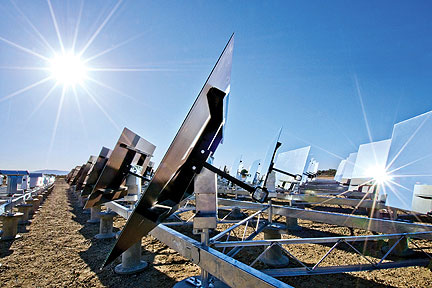The traditional method used to harness solar power is the direct conversion of solar radiation to electricity, through the photo-voltaic cell. Another method is Concentrated Solar Power (CSP), which uses mirrors (heliostats) to reflect the sun’s radiation to a receiver. The receiver then heats water to steam that in turn rotates a turbine to produce electricity. Traditionally, CSP has proved to be an expensive route to solar power. However, California-based company eSolar is ready to take on even fossil fuels in its vision to expand CSP.

Heliostats reflect sunlight to the receiver
The cost-effectiveness of eSolar’s solution to solar power comes from its easy and rapid construction processes. The dual-axis heliostats are mass-manufactured and hence eSolar benefits from economies of scale. Moreover, the heliostats are installed “low to the ground and using minimal labor”. One module contains thousands of heliostats facing in north and south directions. One unit consists of 12 modules and has the ability to generate 46MW of power. Depending on how much power the customer needs, any number of repeatable units can be set up. This easily scalable solution does not damage the environment as the heliostats do not dig into the soil. Furthermore, eSolar only sets up units where the land has already been cultivated, thus not destroying greenery. The obvious trade off is that for processes that need power 24/7, these heliostats are not suitable. This is due to the fact that the sun is not available for the entire day.

Workers manually setting up heliostats
The heliostats themselves were designed using SolidWorks. 20 licenses of SolidWorks were used to design precise mirror specifications that were sturdy in the face of strong winds, at the same time maneuverable electronically. The use of computer-aided design provided a standardized model for the firms who mass-manufactured the heliostats and eliminated “a full prototype cycle that usually takes up to four months”. According to Rick Ianello, vice president of manufacturing at eSolar: “SolidWorks software played a critical role in helping us refine the technology quickly so we could start shopping our scalable plant design around”. It is evident here that design engineering plays a crucial role in expediting the initial phases of product development.

Computer-generated model of a heliostat
eSolar currently powers 4,000 homes in Los Angeles and is a partner of General Electric, which recently invested $40 million in the company. Bandel Carano, an investment manager said that “combining eSolar’s cost-effective and scalable solar technology with GE’s expertise in power generation will deliver an innovative solution that will lower the cost of solar and bring more renewable energy projects online”. With eSolar expanding its customer base to places like sub-Saharan Africa, it is possible that CSP might one day overtake fossil fuels in the pecking order to provide energy to the world.

The future looks bright for eSolar
References used:
http://www.esolar.com/index.html
http://www.designworldonline.com/cad-software-part-of-green-initiative/#_
http://www.solidworks.com/sw/8586_7143_ENU_HTML.htm
http://www.sciencedirect.com/science/article/pii/S0038092X10000216

Excellent blog. It all comes down to economics, and you do not quite address that.
Solar and wind are intermittent but somewhat predictable. The electricity they produce should be fed into the grid, or stored in batteries locally. In some cases you can use it directly such as pumping water out of the ground – use started in earlier days of US agriculture